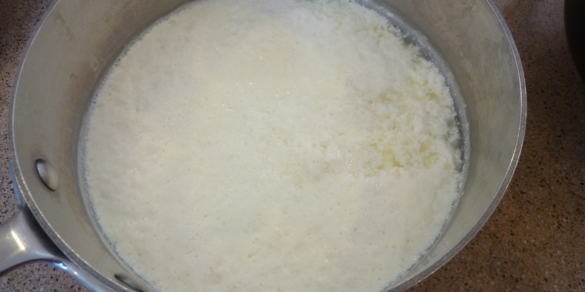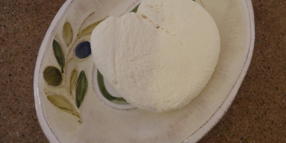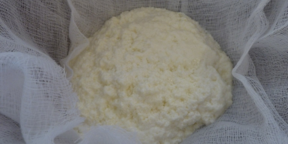
The basic recipe approximates fresh Italian ricotta. Classic ricotta method relies on whey leftover from another cheese-making project (ricotta literally means recooked). Few of us have time for two such projects in one day, and luckily this simple alternative turns out cheese every bit as creamy and sweet (if not authentic). For a lower fat version omit the cream and increase milk to 8 cups. Best consumed within two days.
Tuck into homemade ravioli or spread on grilled artisan bread, topped with toasted walnuts and a drizzle of honey.
Note: do not use ultra-pasteurized milk as it can inhibit the forming of curds.
Makes about 2 cups
Ingredients:
- 7 cups whole milk
- 1 cup heavy cream
- ½ teaspoon non-iodized salt
- ¼ cup freshly squeezed lemon juice
Before you begin, wash all equipment with hot, soapy water and air-dry to avoid unwelcome bacteria.
Pour milk, cream and salt into a heavy-bottomed, stainless steel or enameled pot. Slowly warm over medium-low heat to 185 ° F, stirring now and then. If you don’t have a thermometer, heat until milk is just about to boil (you’ll notice a few bubbles dancing at the edge of the pan while the inner surface trembles). Take time to heat slowly. This process can’t be rushed, or you may end up scorching the milk.
Meanwhile line a colander with several layers of cheesecloth cut about 18 inches square. You’ll need at least 2 layers for drier cheese and about 6 for typical ricotta consistency. Place the colander in a large mixing bowl.
When the milk reaches the right temperature turn off the heat, add lemon juice and stir gently to mix. Allow liquid to stand, undisturbed, for 15 minutes. You’ll notice curds separating from the whey — lumpy flecks of white floating in the yellowish liquid.

Pressed paneer, ready to slice and pan-fry.
Using a ladle or measuring cup, spoon curds into the cheesecloth-lined colander. Whey will drain into the bowl. Allow cheese to drain for 5 to 10 minutes for a soft texture. For a drier consistency, tie ends of the cloth securely around a wooden spoon and set spoon across the top of a pot allowing the bag of cheese to hang. Drain for at least 15 minutes. And before you dump the leftover whey down the drain, consider that it has all kinds of surprising uses.
Variations: For queso blanco, follow the recipe above draining for at least 4 hours at room temperature. Crumble over Mexican favorites like tacos or bean tostadas loaded with crisp lettuce.
For paneer, follow instructions to hanging curds. Gently squeeze the cheesecloth-wrapped ball to release as much excess whey as possible. Hang and drain for 10 minutes. Remove the cloth-wrapped ball from the spoon and twist ends of the cheesecloth around each other so cheese won’t leak out. Place on a plate with twisted ends to one side. Add another plate on top and weigh down with a couple of cans borrowed from the pantry. Refrigerate for at least an hour. Remove cheese from cloth. For a simple appetizer, slice into cubes and pan-fry in a hot skillet — coated with a little olive oil and a sprinkling of salt, turmeric and cayenne — until golden-brown on two sides. Serve with cilantro chutney for dipping.
Now try these recipes with your freshly-made whole-milk cheese (that is if you have any left after the hungry-masses descend to take just a “tiny taste”)…


